 Inspection for Damage at the Top of Masonry Chimneys, Antennas on Chimneys
Inspection for Damage at the Top of Masonry Chimneys, Antennas on Chimneys
- POST a QUESTION or COMMENT about what chimney damage & problems can be spotted from the rooftop - on roof chimney inspections
Masonry chimney top damage inspection points:
This article describes chimney defects and hazards that can be observed from on-roof access, including damage to a masonry chimney top, antennas mounted on chimneys, shared flues, damaged or missing chimney cap, damaged chimney flue, creosote hazards, & angled chimney flue hazards.
InspectAPedia tolerates no conflicts of interest. We have no relationship with advertisers, products, or services discussed at this website.
- Daniel Friedman, Publisher/Editor/Author - See WHO ARE WE?
Damage Inspection at the Top of Masonry Chimneys

A good rain cap or chimney cap (DF's terms) does more than keep out the rain; it also improves chimney draft and prevents downdrafts inside the chimney in windy conditions.
A masonry rain cap such as the one shown in our photo at left can be an effective chimney shelter if it extends past the sides of the chimney and if it is secure.
The chimney shown is a single-wythe flue in Brooklyn, NY.
The above-roof section of this chimnbey is about to collapse - the chimney is unsafe.
[Click to enlarge any image]
We discuss repairs to chimneys at the roof top
at CHIMNEY REPAIRS, TOP & CLAY FLUE TILE.
Other photos and examples of chimney top damage at masonry chimneys can be found
at CHIMNEY CAP & CROWN DEFINITIONS
Damaged Masonry Chimney Tops: loose bricks, blocks, stones
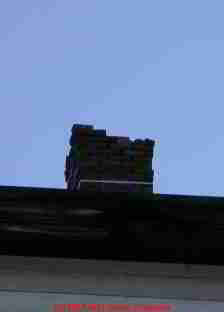
Our photos above show two unsafe chimneys that were still in active use.
Notice those missing bricks and lost mortar? Damaged chimney top masonry such as missing bricks and a missing chimney cap were easily spotted from ground level at both the Coolidge Hotel in Vermont (above left) and the private home in New York (above right).
Missing Chimney Top Bricks & Caps
The chimney shown here illustrates two, possibly three serious problems:
- The chimney top seal or crown has deteriorated, allowing water and frost damage to the chimney structure and perhaps the chimney flue; the risks are fire and carbon monoxide hazards as well as improper heating appliance operation.
See CHIMNEY INSPECTION at ROOFTOP for more examples of chimney top problems that can best be seen from direct access to the rooftop. - There is no chimney cap installed on the flue, risking improper or inadequate draft, downdrafts, and rain or frost damage to the chimney flue.
See CHIMNEY CAP & CROWN DEFINITIONS. - The to flue tile or liner may be cracked
What about those missing bricks? The home inspector or owner should ask, "Where did those bricks go?
are they blocking the flue? Is the flue damaged and unsafe? What repairs are needed before we
install a chimney rain cap?" This chimney may be too short as well - tough to call from
ground level.
See CHIMNEY COLLAPSE RISKS, REPAIRS.
We discuss repairs to chimneys at the roof top
at CHIMNEY REPAIRS, TOP & CLAY FLUE TILE.
Our photo shows a chimney with a cracked, damaged, leaky top seal or "crown" and missing rain cap on the flue.
This chimney needs repairs to its top seal and also it needs a rain cap.
Various experts have proposed design details to avoid cracking at the flue liner/concrete interface at the chimney top.
Inspecting homes in both cold and hot climates, wherever we've seen chimney top damage of the sort shown here, it was traced to water (or frost) and not to the absence of a magic expansion gasket.
[Click to enlarge any image]
Antennas Mounted on Chimneys
We also find chimneys used as a mounting spot for antennas or other equipment. Chimneys are not intended to function as a support for other building components.
Mounting an antenna on a chimney may damage the chimney making it unsafe or causing building leaks. You're also inviting a lightning strike on your chimney by mounting equipment there.
A lightning strike on a chimney can cause severe damage to a home, including setting it on fire. Some readers have reported just that happening to their home. Sketch courtesy of Carson Dunlop.
Photo below: an antenna resting on or supported by a metal chimnney top, Padova, Italy.
Obstructed or Blocked Chimney Flues
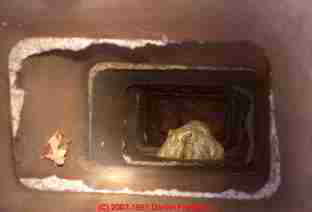
Obstructed or Blocked Chimney Flues might be discovered by inspection and luck as shown here.
A hornets nest is partly blocking this flue. Not only may there be a chimney safety or performance problem, there could be a problem for the inspector or the building occupants when the hornets are disturbed.
A meticulous chimney mason would also criticize the mason who built this chimney for leaving oozed mortar sticking into the flue between each pair of flue tile liners.
That detail
can make a chimney hard to clean and can make for damage and flue leaks if the mortar "ears" are
broken off during chimney cleaning.
We were able to take this clever photo of a dark chimney interior by using our Maglite™ flashlight along
with a Nikon Coolpix 4500™ camera on which we re-set the ISO or equivalent film speed to its
highest setting (800). This trick with a digital camera will sometimes let an inspector "see" into
a pretty dark area.
Angled Flue Tiles
Just as we reported that a clay tile lined chimney would be difficult to clean due to projecting concrete between vertically-stacked clay chimney tiles, clay tiles need to be cut properly when constructing an angled chimney such as the one shown in Carson Dunlop Associates [at REVIEWERS] sketch.
Only the bottom design, showing that the clay chimney tile was cut on an angle, is correct. The top two designs risk both cleaning difficulties and also water, smoke, soot,or creosote leaks into the chimney structure.
Details are at Angled Chimney Flues
Determine the Extent of Chimney Damage and the Safety of the Entire Chimney Flue
First, you will want to be absolutely sure that the chimney damage, whether to the ceramic clay flue liner or to the surrounding masonry or both, is limited to the upper, visible, accessible part of the chimney.
Other chimney damage lower in the chimney itself as it passes through or alongside the building could be very dangerous, even fatal if carbon monoxide or other flue gases leak into the building or if sparks cause a fire.
We suggest that you hire a professional chimney sweep who can examine the entire flue. Most chimney sweeps also offer repair services, and can suggest what repairs are needed and give alternatives for the particular chimney and flue on your building.
We discuss repairs to chimneys at the roof top at CHIMNEY REPAIRS, TOP & CLAY FLUE TILE
Chimney Top Cap, Crown, Rain Cap Article Series Contents
- CHIMNEY CAP / CROWN CONSTRUCTION
- CHIMNEY CAP & CROWN DEFINITIONS
- CHIMNEY "CAP" CROWN / TOP SEAL INSPECTION
- CHIMNEY RAIN CAP / RAIN COVER INSPECTION
- CHIMNEY RAIN CAP / RAIN COVER DIY
- CHIMNEY RAIN CAP VENT OPENING SIZE
- CHIMNEY POTS & DECORATIVE TOPS
- CHIMNEY TOP MASONRY DAMAGE
...
Continue reading at CHIMNEY CAP & CROWN DEFINITIONS or select a topic from the closely-related articles below, or see the complete ARTICLE INDEX.
Or see these
Recommended Articles
- CHIMNEY INSPECTION at ROOFTOP
- CHIMNEY REPAIRS, TOP & CLAY FLUE TILE
- CHIMNEY INSPECTION DIAGNOSIS REPAIR - home
Suggested citation for this web page
CHIMNEY TOP MASONRY DAMAGE at InspectApedia.com - online encyclopedia of building & environmental inspection, testing, diagnosis, repair, & problem prevention advice.
Or see this
INDEX to RELATED ARTICLES: ARTICLE INDEX to CHIMNEYS & FLUES
Or use the SEARCH BOX found below to Ask a Question or Search InspectApedia
Ask a Question or Search InspectApedia
Try the search box just below, or if you prefer, post a question or comment in the Comments box below and we will respond promptly.
Search the InspectApedia website
Note: appearance of your Comment below may be delayed: if your comment contains an image, photograph, web link, or text that looks to the software as if it might be a web link, your posting will appear after it has been approved by a moderator. Apologies for the delay.
Only one image can be added per comment but you can post as many comments, and therefore images, as you like.
You will not receive a notification when a response to your question has been posted.
Please bookmark this page to make it easy for you to check back for our response.
Comments
IF above you see "Comment Form is loading comments..." then COMMENT BOX - countable.ca / bawkbox.com IS NOT WORKING.
In any case you are welcome to send an email directly to us at InspectApedia.com at editor@inspectApedia.com
We'll reply to you directly. Please help us help you by noting, in your email, the URL of the InspectApedia page where you wanted to comment.
Citations & References
In addition to any citations in the article above, a full list is available on request.
- "Chimneys and Vents," Mark J. Reinmiller, P.E., ASHI Technical Journal, Vol. 1 No. 2 July 1991 p. 34-38.
- "Chimney Inspection Procedures & Codes," Donald V. Cohen was to be published in the first volume of the 1994 ASHI Technical Journal by D. Friedman, then editor/publisher of that publication. The production of the ASHI Technical Journal and future editions was cancelled by ASHI President Patrick Porzio. Some of the content of Mr. Cohen's original submission has been included in this more complete chimney inspection article: CHIMNEY INSPECTION DIAGNOSIS REPAIR . Copies of earlier editions of the ASHI Technical Journal are available from ASHI, the American Society of Home Inspectors.
- Natural Gas Weekly Update: http://tonto.eia.doe.gov/oog/info/ngw/ngupdate.asp Official Energy Statistics from the U.S. Government
- US Energy Administration: Electrical Energy Costs http://www.eia.doe.gov/fuelelectric.html
- Ceramic Roofware, Hans Van Lemmen, Shire Library, 2008, ISBN-13: 978-0747805694 - Brick chimneys, chimney-pots and roof and ridge tiles have been a feature of the roofs of a wide range of buildings since the late Middle Ages. In the first instance this ceramic roofware was functional - to make the roof weatherproof and to provide an outlet for smoke - but it could also be very decorative.
The practical and ornamental aspects of ceramic roofware can still be seen throughout Britain, particularly on buildings of the Victorian and Edwardian periods. Not only do these often have ornate chimneys and roof tiles but they may also feature ornamental sculptures or highly decorative gable ends. This book charts the history of ceramic roofware from the Middle Ages to the present day, highlighting both practical and decorative applications, and giving information about manufacturers and on the styles and techniques of production and decoration.
Hans van Lemmen is an established author on the history of tiles and has lectured on the subject in Britain and elsewhere. He is founder member and presently publications editor of the British Tiles and Architectural Ceramics Society. - Chimney Inspection Checklist, Carson Dunlop, Associates, Toronto, Ontario
- Chimney & Stack Inspection Guidelines, American Society of Civil Engineers, 2003 - These guidelines address the inspection of chimneys and stacks. Each guideline assists owners in determining what level of inspection is appropriate to a particular chimney and provides common criteria so that all parties involved have a clear understanding of the scope of the inspection and the end product required. Each chimney or stack is a unique structure, subject to both aggressive operating and natural environments, and degradation over time. Such degradation may be managed via a prudent inspection program followed by maintenance work on any equipment or structure determined to be in need of attention. Sample inspection report specifications, sample field inspection data forms, and an example of a developed plan of a concrete chimney are included in the guidelines. This book provides a valuable guidance tool for chimney and stack inspections and also offers a set of references for these particular inspections.
- Fireplaces, a Practical Design Guide, Jane Gitlin
- Fireplaces, Friend or Foe, Robert D. Mayo
- NFPA 211 - Standards for Chimneys & Fireplaces, NFPA 211: Standard for Chimneys, Fireplaces, Vents, and Solid Fuel-Burning Appliances, 2006 Edition (older editions and standards are found at the same bookstore)
- Principles of Home Inspection: Chimneys & Wood Heating, in (Principles of Home Inspection), Carson Dunlop, Associates, Toronto, Ontario
- NFPA 211 - Standards for Chimneys & Fireplaces, NFPA 211: Standard for Chimneys, Fireplaces, Vents, and Solid Fuel-Burning Appliances, 2006 Edition (older editions and standards are found at the same bookstore)
- NFPA #211-3.1 1988 - Specific to chimneys, fireplaces, vents and solid fuel burning appliances.
- NFPA # 54-7.1 1992 - Specific to venting of equipment with fan-assisted combustion systems.
- GAMA - Gas Appliance Manufacturers' Association has prepared venting tables for Category I draft hood equipped central furnaces as well as fan-assisted combustion system central furnaces.
- National Fuel Gas Code, an American National Standard, 4th ed. 1988 (newer edition is available) Secretariats, American Gas Association (AGA), 1515 Wilson Blvd., Arlington VA22209, and National Fire Protection Association (NFPA), Batterymarch Park, Quincy MA 02269. ANSI Z223.1-1988 - NFPA 54-1988. WARNING: be sure to check clearances and other safety guidelines in the latest edition of these standards.
- Fire Inspector Guidebook, A Correlation of Fire Safety Requirements Contained in the 1987 BOCA National Codes, (newer edition available), Building Officials and Code Administrators International, Inc. (BOCA), Country Club HIlls, IL 60478 312-799-2300 4th ed. Note: this document is reissued every four years. Be sure to obtain the latest edition.
- Uniform Mechanical Code - UMC 1991, Sec 913 (a.) Masonry Chimneys, refers to Chapters 23, 29, and 37 of the Building Code.
- New York 1984 Uniform Fire Prevention and Building Code, Article 10, Heating, Ventilating, and Air Conditioning Requirements
- New York 1979 Uniform Fire Prevention & Building Code, The "requirement" for 8" of solid masonry OR for use of a flue liner was listed in the One and Two Family Dwelling Code for New York, in 1979, in Chapter 9, Chimneys and Fireplaces, New York 1979 Building and Fire Prevention Code:
- NFPA 211 - 3-1.10 - Relining guide for chimneys
- NFPA 211 - 3-2 - Construction of Masonry Chimneys
- NFPA 211 - 3-3 - Termination Height for chimneys
- NFPA 211 - 3-4 - Clearance from Combustible Material
- NFPA 54 - 7-1 - Venting of Equipment into chimneys
- Brick Institute of America - Flashing Chimneys
Brick Institute of America - Proper Chimney Crowns
Brick Institute of America - Moisture Resistance of Brick - American Gas Association - New Vent Sizing Tables
- Chimney Safety Institute of America - Chimney Fires: Causes, Effects, Evaluation
- National Chimney Sweep Guild - Yellow Pages of Suppliers
- "Top Ten Chimney (and related) Problems Encountered by One Chimney Sweep," Hudson Valley ASHI education seminar, 3 January 2000, contributed by Bob Hansen, ASHI
- Chimney Inspection Checklist, Carson Dunlop, Associates, Toronto, Ontario
- "Rooftop View Turns to Darkness," Martine Costello, Josh Kovner, New Haven Register, 12 May 1992 p. 11: Catherine Murphy was sunning on a building roof when a chimney collapsed; she fell into and was trapped inside the chimney until rescued by emergency workers.
- In addition to citations & references found in this article, see the research citations given at the end of the related articles found at our suggested
CONTINUE READING or RECOMMENDED ARTICLES.
- Carson, Dunlop & Associates Ltd., 120 Carlton Street Suite 407, Toronto ON M5A 4K2. Tel: (416) 964-9415 1-800-268-7070 Email: info@carsondunlop.com. Alan Carson is a past president of ASHI, the American Society of Home Inspectors.
Thanks to Alan Carson and Bob Dunlop, for permission for InspectAPedia to use text excerpts from The HOME REFERENCE BOOK - the Encyclopedia of Homes and to use illustrations from The ILLUSTRATED HOME .
Carson Dunlop Associates provides extensive home inspection education and report writing material. In gratitude we provide links to tsome Carson Dunlop Associates products and services.


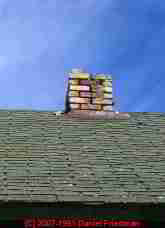

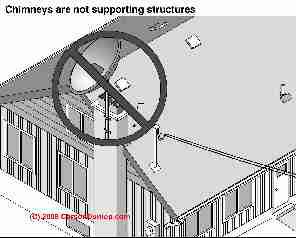
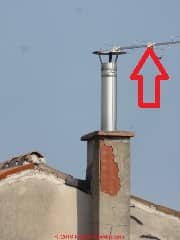
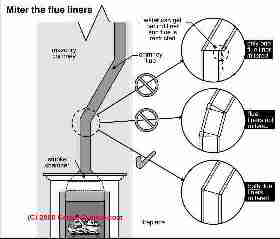
No one has commented yet. Be the first!